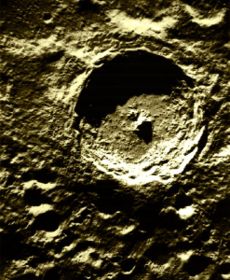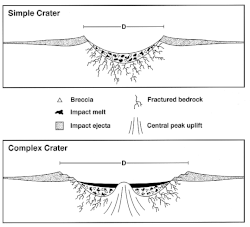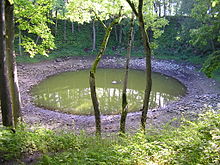Impact crater





Impact craters are formed by meteorites or comets striking the Earth or other solid body. There is a system for recording and assessing craters.[1]
Largest craters on Earth[change | change source]
The five largest confirmed impact structures are:
- Vredefort crater, South Africa: 160 km diameter, 2023 million years ago.[2]
- Chicxulub crater, Mexico: 150 km diameter, 65 million years ago.
- Sudbury Basin, Ontario, Canada: 130 km diameter, 1850 million years ago.
- Popigai crater, Russia: 90 km diameter, 35.7 million years ago.
- Acraman crater, 90 km diameter, South Australia, ~590 mya.
- Manicouagan crater, Quebec, Canada: 70 km diameter, 214 million years ago.
There are some other suggested impact structures which are larger. It is a feature of the Earth that climate, weathering and plate tectonics removes most of the older features and events. In comparison, the Moon retains a nearly complete record of its past impact events. The implication is that the Earth once suffered a similar bombardment in its early history. This period is known as the Late Heavy Bombardment, because it occurred after the Moon was (presumably) knocked from the Earth.
Largest unconfirmed craters[change | change source]
- Australian impact structure: Northern Territory/South Australia, Australia: multiple rings 600 km, 545 million years ago at the Neoproterozoic/Cambrian boundary.[3] Two massive impacts were responsible.
- Shiva crater, Indian Ocean, west of India: ~600 km length, 400 km width, 65 million years ago. Obviously this is of high interest, because of the date.
- Wilkes Land crater, Antarctica: 485 km. 250–500 mya.
- Nastapoka arc, Nunavut/Quebec, Canada: 450 km. unknown
- Ishim impact structure,[4] Kazakhstan: 300 km. 430–460 mya.[5]
- Bedout, off-shore of Western Australia: 250 km, 250 mya.
Largest named craters in the Solar System[change | change source]
- North Polar Basin/Borealis Basin (disputed) – Mars – Diameter: 10,600 km
- South Pole–Aitken basin – Moon – Diameter: 2,500 km
- Hellas Basin – Mars – Diameter: 2,100 km
- Caloris Basin – Mercury – Diameter: 1,550 km
- Imbrium Basin – Moon – Diameter: 1,100 km
Identifying impact craters[change | change source]

The distinctive mark of an impact crater is the presence of rock which has undergone shock-metamorphic effects, shattered or melted rocks, and crystal deformations.[6] Examples:
- A layer of shattered rock under the floor of the crater. This layer is called a 'breccia lens'.[7]
- Shatter cones, which are chevron-shaped impressions in rocks. Such cones are formed most easily in fine-grained rocks.[6][8][9][10]
- High-temperature rock types, including laminated and welded blocks of sand, tektites, or glassy spatters of molten rock. They may have relatively large amounts of trace elements that are associated with meteorites, such as nickel, platinum, iridium, and cobalt.
- Microscopic pressure deformations of minerals. These include fracture patterns in crystals of quartz and feldspar, and formation of high-pressure materials such as diamond, derived from graphite and other carbon compounds, or varieties of shocked quartz.
References[change | change source]
- ↑ Earth Impact Database
- ↑ Revised estimate. [1]
- ↑ 'Largest ever asteroid impact' site found in Australia: [2]
- ↑ Frank Dachille (1976). "Frequency of the formation of large terrestrial impact craters". Meteoritics. 11: 270. Bibcode:1976Metic..11..270D.
- ↑ Zeylik B. S.; Seytmuratova E. Yu, 1974: A meteorite-impact structure in central Kazakhstan and its magmatic-ore controlling role. Doklady Akademii Nauk SSSR: 1, Pages 167-170
- ↑ 6.0 6.1 French B.M. 1998. Traces of catastrophe: a handbook of shock-metamorphic effects in terrestrial meteorite impact structures. LPI Contribution #954. Houston, Texas, USA: Lunar and Planetary Institute. [3]
- ↑ Breccia is a rock composed of broken fragments of minerals or rock cemented together by a fine-grained matrix,[4] Archived 2001-12-25 at the Wayback Machine
- ↑ Shatter cones are rare geological features that are only known to form in the bedrock beneath meteorite impact craters or underground nuclear explosions. They are evidence that the rock has been subjected to a high-pressure shock.
- ↑ Sagy, Amir; Fineberg, Jay; Reches, Ze'ev (2004). "Shatter cones: branched, rapid fractures formed by shock impact" (PDF). Journal of Geophysical Research. 109 (B10): B10209. Bibcode:2004JGRB..10910209S. doi:10.1029/2004JB003016. Archived from the original (PDF) on 2009-02-27.
- ↑ French, Bevan M. (2005). "Stalking the wily shatter cone: a critical guide for impact-crater hunters" (PDF). Impacts in the Field. 2 (Winter). Impact Field Studies Group: s 3–10. Archived from the original (PDF) on 2011-07-20. Retrieved 2010-08-11.
